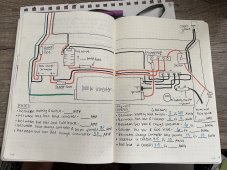GrimQueefer
New Member
- Joined
- Oct 5, 2022
- Messages
- 1
What's going on guys! This is my first time building a van and I'm currently working on the electric system.
I've created a pretty solid wiring diagram and I'm feeling pretty confident, but I just want to get some advice for the last few things.
So you have an idea of what I'm working with, here's what I've got so far:
EDIT: Looking into it further, my solar panels will be wired in parallel, so I believe I will need two 15AMP fuses.
I also changed the fuse from the bus bar to the inverter to a 115 AMP fuse after looking at Renogy's website.
I think I've also determined a 120amp fuse will work between the fuse block and bus bar, but please double check my work hahaha.. please.
I've created a pretty solid wiring diagram and I'm feeling pretty confident, but I just want to get some advice for the last few things.
So you have an idea of what I'm working with, here's what I've got so far:
- 200 Watt Solar Starter Kit with 30Amp Solar Charge Controller- Renogy
- 200AH Deep Cycle Battery - Renogy
- 1000W Inverter - Renogy
- Victron Battery Monitor
- Blue Sea Systems ST Blade Fuse block
- Main System Switch
- Negative and Positive Bus Bars
- Is it appropriate to use 2/0 AWG Wire from the positive bus bar to the DC Panel?
- What's the appropriate fuse size between the bus bar to the Fuse Block (Fuse block says Max Amps: 100a per block, 30a per circuit)
- I plan on using a terminal fuse block on the battery as a fail safe, I'm having a hard time figuring out the fuse size for this?
- Renogy recommends an 18amp fuse between the Charge Controller and the panels. Should I use a 20 amp fuse instead?
- Is it appropriate to use 5.5 feet of 10 AWG wire between the bus bar to the charge controller? And to consolidate wiring could I use 10 AWG for my DC Loads also?
- Does a 150 Amp fuse seem right in between the bus bar and Inverter.
EDIT: Looking into it further, my solar panels will be wired in parallel, so I believe I will need two 15AMP fuses.
I also changed the fuse from the bus bar to the inverter to a 115 AMP fuse after looking at Renogy's website.
I think I've also determined a 120amp fuse will work between the fuse block and bus bar, but please double check my work hahaha.. please.
Attachments
Last edited:



